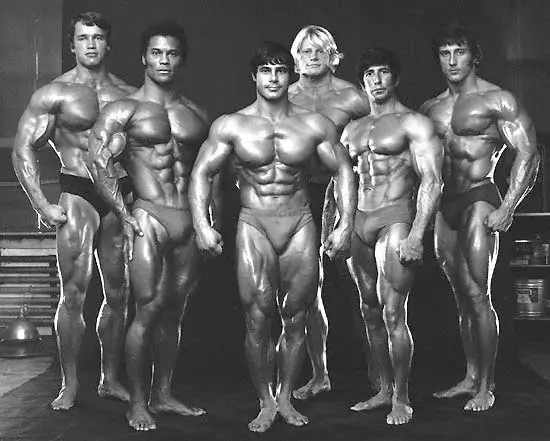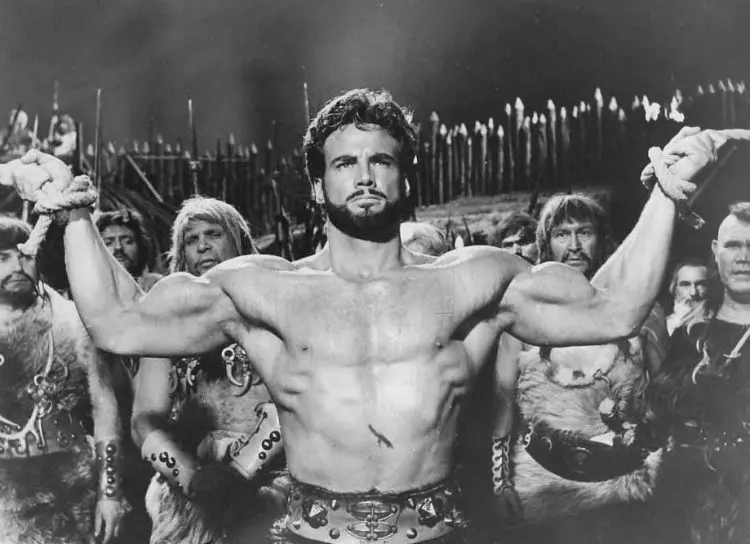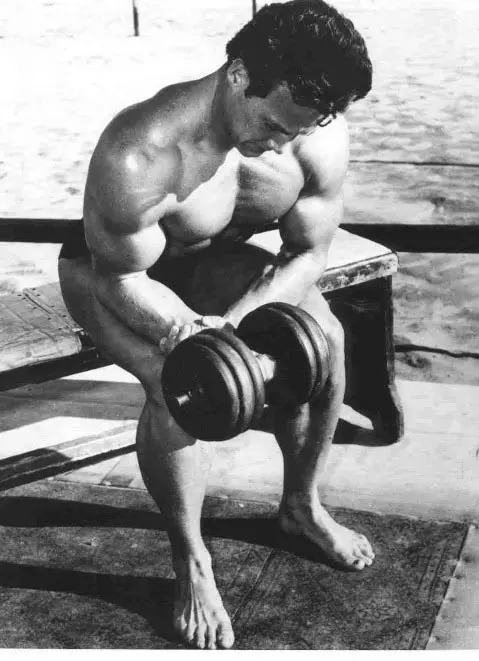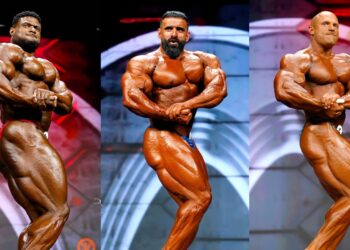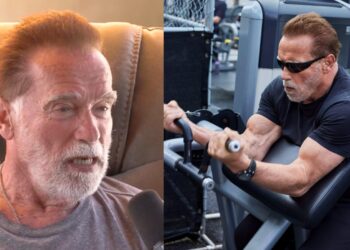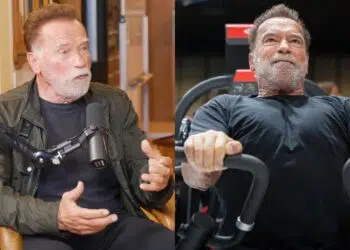Like most sports, bodybuilding has changed enormously over the last few decades. Modern-day competitors often weigh in at close to 300lbs, and their ripped physiques make them look like walking anatomy charts.
Bodybuilding is very much a sport of extremes, and many of today’s bodybuilding stars look like they belong to an entirely different species of humans!
However, this has not always been the case.
Bodybuilders from the 1950s, 1960s, and 1970s were more lightly muscled, and extreme leanness was rare. To many bodybuilding fans, the physiques of yesteryear are far more appealing than those of today, and this time is often called the “golden era of bodybuilding.”
Steve Reeves Statistics
| Full Name: Steve Reeves “Hercules” | ||
| Weight | Height | Date of Birth |
| 213 lbs (97 kg) | 6′ 1″ (185 cm) | January 21, 1926 |
| Died | Birthplace | Chest |
| May 1, 2000 | Glasgow, Montana, USA | 52″ (123 cm) |
| Thighs | Waist | Calves |
| 26″ (66 cm) | 29″ (74 cm) | 18″ (46 cm) |
Legendary bodybuilders of this era include:
- Arnold Schwarzenegger
- Lou Ferrigno
- Reg Park
- Frank Zane
- Larry Scott
- Serge Nubret
- Franco Columbu
- John Grimek
- Robby Robinson
- Dave Draper
However, of all the golden-era greats, one bodybuilder is most commonly said to have had the most aesthetic physique – Steve Reeves.
Level Up Your Fitness: Join our 💪 strong community in Fitness Volt Newsletter. Get daily inspiration, expert-backed workouts, nutrition tips, the latest in strength sports, and the support you need to reach your goals. Subscribe for free!
Even now, more than 70 years after he left competitive bodybuilding, Reeve’s physique is still considered the to be the gold standard for symmetry and balance.
In this article, we reveal how Reeves trained to develop the ultimate classic physique.
Who Was Steve Reeves?
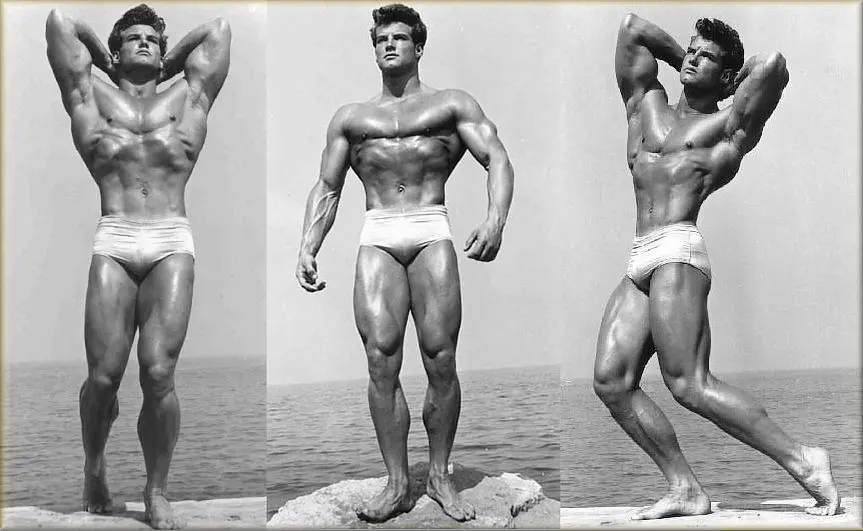
Stephen Lester Reeves was born in 1926 in Glasgow, Montana. However, at age ten, shortly after his father died, he moved to Oakland, California.
Always an athletic child, Reeves was surprised when he was beaten by a much smaller boy in an arm-wrestling match, and this triggered a lifelong interest in muscle and strength. He built his own home gym and started doing basic barbell and bodyweight exercises in the family’s garage.
Reeves responded well to the weights and soon started to pack on muscle. Inspired by the health and fitness magazines of the day, he decided to become a bodybuilder. Luckily for Reeves, he lived in what was then the mecca of bodybuilding, California, and joined a “real” gym as soon as he was able.
Army Career
After graduating from high school in 1944, Reeves joined the US Army and served for two years. Despite his hectic schedule, he continued his bodybuilding workouts, albeit infrequently.
A bout of malaria stripped 25 pounds from Reeves’ frame. Still, as he neared the end of his time in the military, he regained the lost weight and left the army in pretty good shape, weighing almost the same as when he joined up.
Bodybuilding
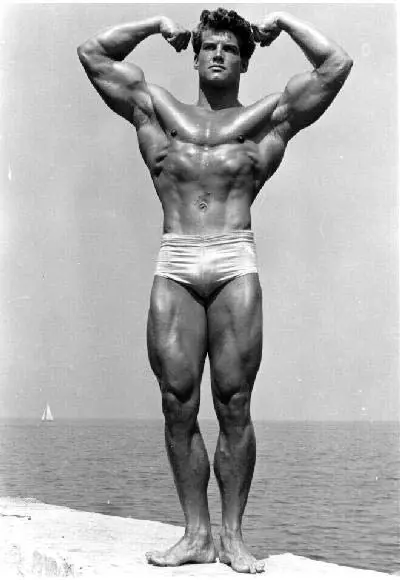
After leaving the army, Reeves returned to California and began training in earnest. He set his sights on the 1946 Mr. Pacific Coast bodybuilding competition, which he won easily.
In 1947 he successfully defended his Pacific Coast title and went on to win the Mr. America. 1948 saw Reeve’s bodybuilding journey go international, and he won the Mr. Universe and Mr. World titles.
1949 was not a good year for Reeves, as he tried to balance bodybuilding with his fledgling acting career. Still, in 1950, he came back for one last stab at the Mr. Universe title, which he won.
Steve Reeve’s competitive career was relatively short. This was when professional bodybuilding was almost unheard of, and cash prizes rarely exceeded $1000. Like most lifters of the day, Reeve’s had to balance training and competition with a full-time job, which is no easy feat. He soon realized that he would have to look outside of bodybuilding to make a good living.
Steve Reeves’ Bodybuilding Career Highlights:
- 1946 – AAU Mr. Pacific Coast
- 1946 – AAU Mr. Western America
- 1947 – AAU Mr. Pacific Coast
- 1947 – AAU Mr. America
- 1948 – AAU Mr. Universe (Tall)
- 1948 – Mr. World
- 1950 – NABBA Mr. Universe
At his peak, Reeve’s measurements were:
- Weight: 215lbs
- Biceps: 18.5″
- Chest: 52″
- Thighs: 26”
- Neck: 18.5″
- Calves: 18.5″
- Waist: 29″
Making Movies
Toward the end of his bodybuilding career and after retiring from competition, Reeves broke into acting and got small parts in several minor American films and TV shows. However, his big break came in 1957 when he went to Italy to star in Pietro Francisci’s movie, Hercules.
This movie became a major box office success earning $5 million in the US alone. The success of this film led to a sequel, Hercules Unchained. Both films quickly became cult classics and popularized an entire “swords and sandals” action movie genre.
Later Life and Death
A lifelong advocate of drug-free bodybuilding and healthy eating, Steve Reeves continued training long after retiring from bodybuilding and movies and maintained a physique that defied his age. He wrote two bodybuilding books – Building the Classic Physique the Natural Way, and Dynamic Muscle Building. He also wrote a book on his favorite cardio workout, power walking.
In 1990 he bought a ranch in Valley Center, where, with his wife, he bred horses.
Steve Reeves died after suffering a blood clot two days after a routine surgery in 2000 at the age of 74.
Steve Reeves Bodybuilding Workout
Like almost every bodybuilder in history, Steve Reeves used a range of workouts and routines to build his award-winning physique. His training plans changed depending on whether he was preparing for a bodybuilding show or a movie. He also adjusted his workouts based on any perceived weakness that needed extra attention.
However, like many bodybuilders at the time, Steve Reeves almost always did full-body workouts and trained three times per week. Split routines only really became popular after Reeves retired from competitive bodybuilding.
Reeves was very particular about the order of the exercises in his workouts and tended to work from small muscle groups up to big. This, Reeves believed, ensured he was fully warmed up when it came time to do the heaviest, most demanding exercises in his workout.
This bodybuilding program is the one Reeves used to gain the greatest amount of muscle mass in his bodybuilding career. Think of it as the Steve Reeves Classic Bulking Program!
The Steve Reeves Workout
- Level: Intermediate/advanced.
- Workout type: Full-body.
- Schedule: Three times per week on non-consecutive days, e.g., Monday, Wednesday, and Friday.
- Duration: 90 minutes to 2 hours.
- Rest and recovery: 30-60 seconds between sets and two minutes between exercises.
- Tempo: Lift in 2-3 seconds and lower in 2-3 seconds on all exercises except swings.
- Progression: Increase the weights when you can do three sets of the upper rep range with perfect form.
- Equipment: Barbell, dumbbells, squat rack, cable machine.
| # | Exercise | Sets | Reps |
| 1 | Dumbbell Swings (warm-up) | 3 | 15-20 |
| 2 | Upright Rows | 3 | 8-12 |
| 3 | One Arm Row | 3 | 8-12 |
| 4 | Dumbbell Laterals | 3 | 8-12 |
| 5 | Incline Press | 3 | 8-12 |
| 6 | Triceps Pushdown | 3 | 8-12 |
| 7 | Barbell Curls | 3 | 8-12 |
| 8 | Seated Dumbbell Curls | 3 | 8-12 |
| 9a | Squats | 3 | 8-12 |
| 9b | Pullovers | 3 | 8-12 |
| 10a | Breathing Squats | 1 | 20 |
| 10b | Pullovers | 1 | 20 |
| 11 | Deadlifts | 2 | 8-12 |
| 12 | Good Mornings | 2 | 8-12 |
| 13 | Self-resisted neck lateral flexion | 2 | 12-15 |
Exercises 9a and 9b, and 10a and 10b, are to be done as supersets. This means you do the first exercise (a) and then immediately perform the second exercise (b). Rest a moment and then repeat the pairing as prescribed by the program.
Exercise Instructions
Steve Reeves was a stickler for proper exercise form. Doing exercises correctly ensures that every rep you perform is as effective and safe as possible. Follow these step-by-step instructions to ensure that you do all the exercises in this workout correctly.
1. Dumbbell Swings (warm-up)
Muscles trained: Full-body, especially hips, lower back, and shoulders.
Reeves liked to start his workouts with a few sets of dumbbell swings to warm up his hips, shoulders, and lower back. Don’t go too heavy with this exercise; instead, focus on moving your muscles and joints through a large range of motion.
Steps:
- Hold one dumbbell in both hands in front of your hips. Stand with your feet roughly shoulder-width apart, knees slightly bent. Pull your shoulders down and back, and brace your abs.
- Hinge forward from your hips and lower the dumbbell down between your knees.
- Drive your hips forward, stand up, and swing the weight out and up to about eye level.
- Lower the weight and repeat.
Tips:
- You can also do this exercise with a kettlebell.
- Increase your range of motion as you start to feel warmer.
- Push you’re butt back at the start of each rep to emphasize your hips and hamstrings.
2. Upright Rows
Target muscles: Deltoids, upper and middle trapezius, biceps.
Barbell upright rows were one of Steve Reeves’ favorite shoulder exercises. He believed they helped him to create the V-shaped torso that gave him his famous silhouette. He almost always did this exercise with a barbell but occasionally did upright rows with dumbbells for variety.
Steps:
- Hold a barbell with a narrower than shoulder-width overhand grip. Stand with your feet about hip-width apart, knees slightly bent. Pull your shoulders down and back, and brace your abs.
- Leading with your elbows, pull the bar up the front of your body to just below your chin. Make sure your elbows are higher than your hands.
- Lower the bar down until your arms are straight, and repeat.
Tips:
- You can also do this exercise with an EZ bar or on a cable machine if preferred.
- Use a wider grip if the close grip bothers your elbows, wrists, or shoulders.
- Focus on leading with your elbows to maximally engage your upper traps and deltoids.
3. One Arm Row
Target muscles: Latissimus dorsi, posterior deltoids, biceps.
Despite having a very well-built upper back, Steve Reeves did not do a lot of lat training. In fact, this is your main back exercise. With that in mind, make sure you take your sets close to failure to ensure your lats get a good workout!
Steps:
- Hold a dumbbell in one hand and put your opposite hand and knee on a bench, so your upper body is parallel to the floor. Let the dumbbell hang straight down from your shoulder. Brace your core and pull your shoulder back and down.
- Bend your elbows and pull the weight up and into your lower ribs.
- Extend your arm and repeat.
- Do the same number of reps on both sides.
Tips:
- Keep both feet on the floor if you prefer.
- Think about leading with your elbow and pulling your shoulder back to fully engage all of your back muscles.
- Take care not to round your lower back during this exercise, as doing so could cause injury.
4. Dumbbell Lateral raises
Target muscles: Medial deltoids.
The medial or side deltoids are the part of your shoulders that give them their width. Because of this, they play a critical role in sculpting an impressive V-taper. Steve Reeves put a lot of emphasis on this exercise and had impressively broad shoulders as a result.
Steps:
- Standing with your feet shoulder-width apart, hold a dumbbell in each hand, arms by your sides. Bend your elbows slightly, pull your shoulders down and back, and brace your abs.
- Keeping your arms rigid, raise the weights out to the side and up to shoulder height.
- Lower the weights back down to your sides and repeat.
Tips:
- Raise your little fingers slightly at the top of each rep to increase medial deltoid engagement.
- You can also do this exercise on a cable or dedicated lateral raise machine.
- Do seated lateral raises if preferred.
5. Incline Press
Target muscles: Pectoralis major, anterior deltoids, triceps.
Most bodybuilders start their upper body workouts with bench presses. Still, Reeves was more interested in preserving his V-taper than building massive pecs. As such, the bench press doesn’t even feature in this Steve Reeves bodybuilding workout. Instead, he mostly did incline presses to emphasize his upper chest.
Steps:
- Adjust the incline on your bench to 20-30 degrees. Lie on the bench, so your eyes are directly beneath the barbell. Grip the bar with a slightly wider than shoulder-width overhand grip. Unrack the bar and hold it over your chest.
- Keeping your elbows up and out, bend your arms and lower the bar down to lightly touch your upper chest.
- Drive the bar back up and repeat.
Tips:
- You can also do incline presses with dumbbells.
- Lift your feet off the floor to potentially increase chest engagement.
- Experiment with a wider or narrower grip to see which hits your chest more.
6. Triceps Pushdown
Target muscles: Triceps brachii.
Reeves didn’t use a lot of machines in his workouts. That’s because very few were available. While he could have chosen a freeweight or bodyweight exercise to train his triceps, Steve Reeves usually preferred to do cable pushdowns. This allowed him to fully isolate and engage his triceps.
Steps:
- Attach a straight bar to a high pulley machine. Hold the handle with an overhand, shoulder-width grip. Pull your upper arms down into your sides, brace your abs, and stand with your feet shoulder-width apart.
- Leaning forward slightly, extend your arms and press the handle down to your upper thighs.
- Bend your arms as far as you can without moving your arms away from your sides.
- That’s one rep – keep going!
Tips:
- Use a rope, V-shaped, or EZ bar attachment if preferred.
- Do this exercise kneeling to reduce the risk of cheating.
- Work one arm at a time for variety and to ensure both triceps are trained equally.
7. Barbell Curls
Target muscles: Biceps brachii
Reeves built his impressive arms with a small handful of exercise, and the barbell biceps curl was the cornerstone of his arm workouts. Preacher curls were becoming popular around this time. Still, unlike fellow bodybuilder Larry Scott, Reeves preferred the basic barbell curl for beefing up his biceps.
Level Up Your Fitness: Join our 💪 strong community in Fitness Volt Newsletter. Get daily inspiration, expert-backed workouts, nutrition tips, the latest in strength sports, and the support you need to reach your goals. Subscribe for free!
Steps:
- Stand with your feet about shoulder-width apart. Hold a barbell with an underhand, shoulder-width grip. Pull your shoulders back and down, and brace your abs.
- Keeping your upper arms close to your sides, bend your arms and curl the bar up to around shoulder height.
- Lower the weight back down and repeat.
Tips:
- Use an EZ bar if straight barbell curls bother your elbows or wrists.
- Lean against a wall or post if you tend to use your legs or back to raise the weight.
- You can also do this exercise using a low cable machine.
8. Seated Dumbbell Curls
Target muscles: Biceps brachii.
Dumbbell biceps curls involve a movement called supination, which is the secondary function of the biceps muscle. While barbell curls build biceps size, dumbbell curls may increase your biceps peak.
Steps:
- Sit on an upright exercise bench with a dumbbell in each hand and your arms by your sides. Pull your shoulders down and back, and brace your abs. Your palms should be facing inward.
- Bend your arms and curl the weights up. As your elbows reach 90 degrees, rotate your wrists, so your palms are uppermost. Continue lifting the weights to your shoulders.
- Reverse this action to lower the weights and repeat.
Tips:
- Use an alternating arm action if you wish.
- You can also do this exercise standing instead of seated.
- Hold the dumbbell with the weights nearer to your thumbs to make rotating the weights a little more challenging and increase the resistance to supination.
9a. Squats
Target muscles: Quadriceps, hamstrings, gluteus maximus, abductors, adductors.
Squats have long been viewed as the king of exercises, and it seems like Steve Reeves agreed, as this was his primary lower body movement. Reeves did three hard sets of squats supersetted with pullovers.
Some golden-era bodybuilders believed that this exercise pairing could expand the ribcage. While this may or may not be the case, it’s clear from Reeves’ leg development that heavy squats are an effective lower body exercise.
Steps:
- Rest and hold a barbell across your upper back. Make sure it’s NOT resting on your neck. Stand with your feet about shoulder-width apart, toes turned slightly outward. Brace your abs and lift your chest.
- Bend your knees and squat down until your thighs are roughly parallel to the floor. Do not round your lower back.
- Stand back up and repeat.
Tips:
- Squat deeper than parallel if your flexibility and knee health allow.
- Place your heels on blocks or weight plates to allow you to squat a little deeper.
- You can also do front squats instead of back squats.
9b. Pullovers
Target muscles: Latissimus dorsi, pectorals major.
Pullovers are a single joint exercise that works your chest and upper back. However, as well as being a muscle builder, this exercise was once thought to expand the ribcage and broaden the chest. Either way, it’s an effective upper-body exercise, even if it doesn’t make your ribcage larger.
Steps:
- Lie across a bench, so your shoulders are supported. Press and hold a single dumbbell over your chest. Your arms should be slightly bent but rigid.
- Lower the weight down and behind your head until you feel a good stretch in your lats.
- Pull the weight back up and over your chest.
Tips:
- Drop your hips slightly to increase your range of motion.
- Do this exercise lying along a bench instead of across it if preferred.
- You can also do pullovers with a barbell instead of a dumbbell.
10a. Breathing Squats and Breathing Pullovers
Reeves thought that squats and pullovers were such a potent combination that he did them again. However, for this final superset, he took 2-3 deep breaths between reps. These are called breathing squats and breathing pullovers.
The idea was to expand and stretch your chest and ribs as much as possible. This superset was done with light to moderate weights and for high reps.
Do the exercises as described above, but take a couple of deep breaths between each rep.
11. Deadlifts
Target muscles: Hamstrings, gluteus maximus, quadriceps, erector spinae, latissimus dorsi.
You won’t find many modern lifters who do squats and deadlifts in the same workout, especially after doing so many sets of upper-body training. However, Steve Reeves had superb conditioning and was more than up to the challenge! Reeves did deadlifts to train his posterior chain, including glutes and hammies.
Steps:
- Place a loaded barbell on the floor and stand behind it with your feet about hip-width apart and your toes under the bar.
- Squat down and hold the bar with an overhand, shoulder-width grip. Straighten your arms, drop your hips, and lift your chest. Your lower back should be slightly arched, core braced.
- Drive your feet into the floor and stand up. Do not round your lower back. Keep the barbell close to your legs throughout the exercise.
- Return the barbell to the floor, reset your core and grip, and repeat.
Tips:
- Use a mixed grip (one hand forward, one hand backward) if preferred. Alternatively, you can use wrist wraps to reinforce your grip.
- If you find your lower back rounds during deadlifts, raise the bar and do rack pulls
- Spread your arms and hold onto the weight plates – this is called the Reeves deadlift.
12. Good Mornings
Target muscles: Hamstrings, gluteus maximus, erector spinae.
The final hard exercise in Steve Reeves’ bodybuilding workout hits the posterior chain again. Good mornings are so-called because, when you do them, it looks a bit like you are bowing politely to greet someone. The main thing to remember when doing good mornings is to avoid rounding your lower back, which could cause serious injury.
Steps:
- Rack and hold a barbell on your upper back as if you were going to do squats. Stand with your feet about hip-width apart, knees slightly bent. Brace your abs and pull the bar down onto your back so it won’t move during your set.
- Hinging from your hips, lean forward as far as possible without rounding your lower back.
- Stand back upright and repeat.
Tips:
- Descend until you feel a deep stretch in your hamstrings.
- Make this exercise more comfortable by using a padded safety bar.
- Try cable pull-throughs if you need an easier alternative to this challenging exercise.
13. Self-resisted neck lateral flexion
Target muscles: Neck and upper traps.
According to old-school bodybuilders, your neck, arms, and calves should be the same size. Reeves had good calves from all the power walking he did, but his neck needed extra work to achieve the correct measurement. Self-resisted neck lateral flexion was his exercise of choice.
Steps:
- Seated or standing, place the palm of one hand against the side of your head.
- Press your head against your hand as hard as you can for 2-3 seconds.
- Relax and repeat for the prescribed number of reps.
- Swap sides and repeat.
Tips:
- You can also place your hands on the back of your head to work your neck extensors and the front of your neck to hit the flexors.
- Beef up your neck more by using a weighted head harness.
- Go even more old-school with neck bridges.
Steve Reeves Bodybuilding Diet
The Steve Reeves bodybuilding diet is pretty simple, and he fueled his workouts by eating three square meals a day and a couple of healthy snacks. He purposely ate more when bulking or between competitions, ate less when cutting. He didn’t track macros, weigh his food, or count calories. Instead, he relied on his appetite to tell him how much to eat.
However, Reeves did start each day with what he called a power shake, which he usually consumed instead of a standard breakfast meal.
Reeves’ power shake normally contained the following ingredients:
- 14 ounces (400ml) of freshly squeezed orange juice
- 1 tablespoon of Knox gelatin (a source of collagen and amino acids
- 1 banana
- 2 to 4 raw eggs
- 1 tablespoon of honey
- 2 tablespoons of homemade protein powder (skimmed milk powder, soya powder, and dried egg powder)
After analyzing Reeves’ training journals, it appears he mostly consumed 60% carbs, 20% protein, and 20% fat. Meals were built around whole foods, like lean meat, fish, eggs, veggies, and fruits, with some whole grains on the side. Reeves ate very little sugar or processed foods. He used no supplements because a) he didn’t really believe in them, and b) very few were available during the time.
Steve Reeves Workout FAQs
Do you have a question about the Steve Reeves Workout? Don’t worry; we’ve got the answers!
1. Is the Steve Reeves workout suitable for beginners?
The Steve Reeves workout involves too many exercises and sets for most beginners. It’s more of an intermediate or advanced-level program. Most beginners would quickly become overtrained if they followed it, and a shorter workout would be more appropriate.
2. Why did Steve Reeves only train three times per week?
Split routines only started to become popular in the 1960s and widespread in the 1970s. Before then, almost everyone who lifted weights did thrice-weekly whole-body workouts. This less frequent approach to training worked better for people with manual labor jobs as it allowed extra time for recovery between workouts.
3. What did Steve Reeves do for cardio?
Steve Reeves was a fan of power walking. In fact, he wrote a book about this topic. Power walking involves walking quickly while pumping your arms. Some power walkers also carry light dumbbells or wear weighted backpacks.
Power walking delivers an effective cardio workout while being low-impact and easy on your joints. It’s an excellent option for lifters who are often too heavy to run comfortably. As an added benefit, you can power walk every day, so it’s an ideal strategy for getting and staying lean.
4. What is the Reeves Deadlift?

The Reeves deadlift was a secret exercise that Reeves used to train his glutes, hamstrings, and lower back. It features an ultra-wide grip that takes your posterior chain muscles through a larger-than-usual range of motion.
This is a challenging exercise to don’t go too heavy too soon. Instead, start light and perfect your technique before adding weight to the bar. You’ll need quite long arms to do this exercise; otherwise, you may not be able to reach the barbell plates. If that’s the case, try snatch grip deadlifts instead.
How to do it:
- Position your feet for conventional deadlifts. Bend forward and reach out to grab the top of your weight plates. Drop your hips, lift your chest, and brace your abs. Pull your shoulders down and back.
- Drive your feet into the floor and, without rounding your lower back, stand up straight.
- Lower the bar to the floor and repeat.
5. Did Steve Reeves take steroids?
While steroids had been invented when Reeves was a bodybuilder, very few people used them. Reeves took a strong anti-steroid stance and claimed to be a lifelong natural lifter. Given his modest body weight and muscularity, it seems unlikely that Steve Reeves ever took steroids, and nothing about his appearance suggests otherwise.
6. How can I make the Steve reeves workout shorter?
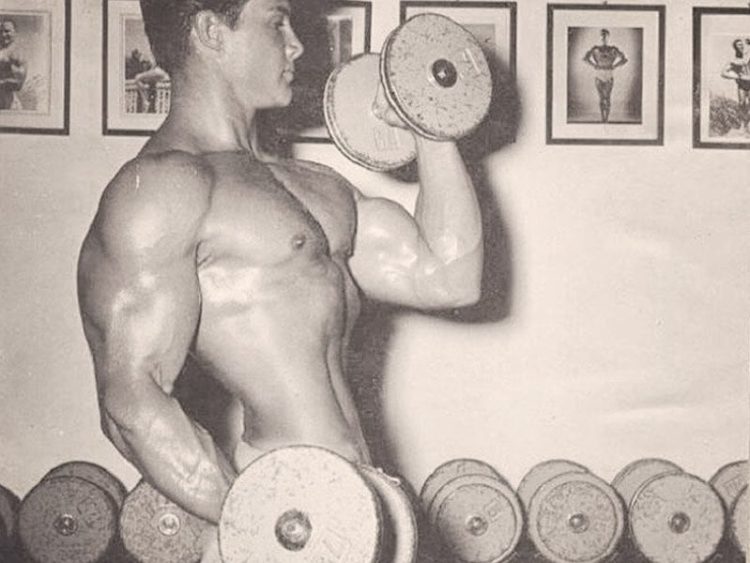
The most obvious way to shorten the Steve Reeves workout is to do fewer sets per exercise. Switching from three to two sets for the major exercise will cut it down by a third.
There are also some exercise redundancies which means you can remove a couple of movements from the program while still training all the same muscles. For example, you could take out the breathing squats and breathing pullovers, good mornings, and dumbbell biceps curls to make the workout shorter.
Alternatively, you could just cut the workout in half and do the upper body exercises one day and the leg exercises the next.
Of course, making any of these changes means you would no longer be doing the Steve Reeves workout!
7. Are full-body workouts better than split workouts?
When it comes to comparing full-body and split workouts, there is no clear winner. For some people, split routines work best, but for others, a full-body program is better.
Rather than worry about which one is best, instead, see which option works for you. The one that slots seamlessly into your lifestyle and that you can stick with for months at a time without missing workouts is the one you should choose.
Read more about full-body vs. split routines and how to choose between them here.
8. How long does it take to get results from the Steve Reeves bodybuilding workout?
The answer to this question will depend on how consistently you train, your diet, and how much sleep you get. You’ll also need to push yourself harder from one workout to the next to keep your muscles growing.
However, Reeves himself reportedly built 35 pounds of muscle in four months using this program, which should give you an idea of what is possible. However, Steve Reeves was also blessed with fantastic genetics, so not everyone will be able to gain as much muscle in such a short time.
That said, you should start seeing your body change after a month or so. If you don’t, it could be that you are not ready for such a high-volume training program or that you aren’t paying enough attention to nutrition and recovery.
Wrapping Up
Steve Reeves had a classic physique. With his broad shoulders, narrow waist, and muscular arms, he looked like a Greek statue. And while genetics played a part in Reeves’ physique, he was also a dedicated lifter who put everything into every workout.
He built his body with very basic equipment, simple programs, and uncomplicated nutrition, and without using steroids.
Reeves was also one of the first muscular movie stars and paved the way for Arnold Schwarzenegger, Sylvester Stallone, The Rock, Chris Hemsworth, and all the others that came after him.
Despite his short competitive career, there is no denying that Steve Reeves was a bodybuilding legend.

